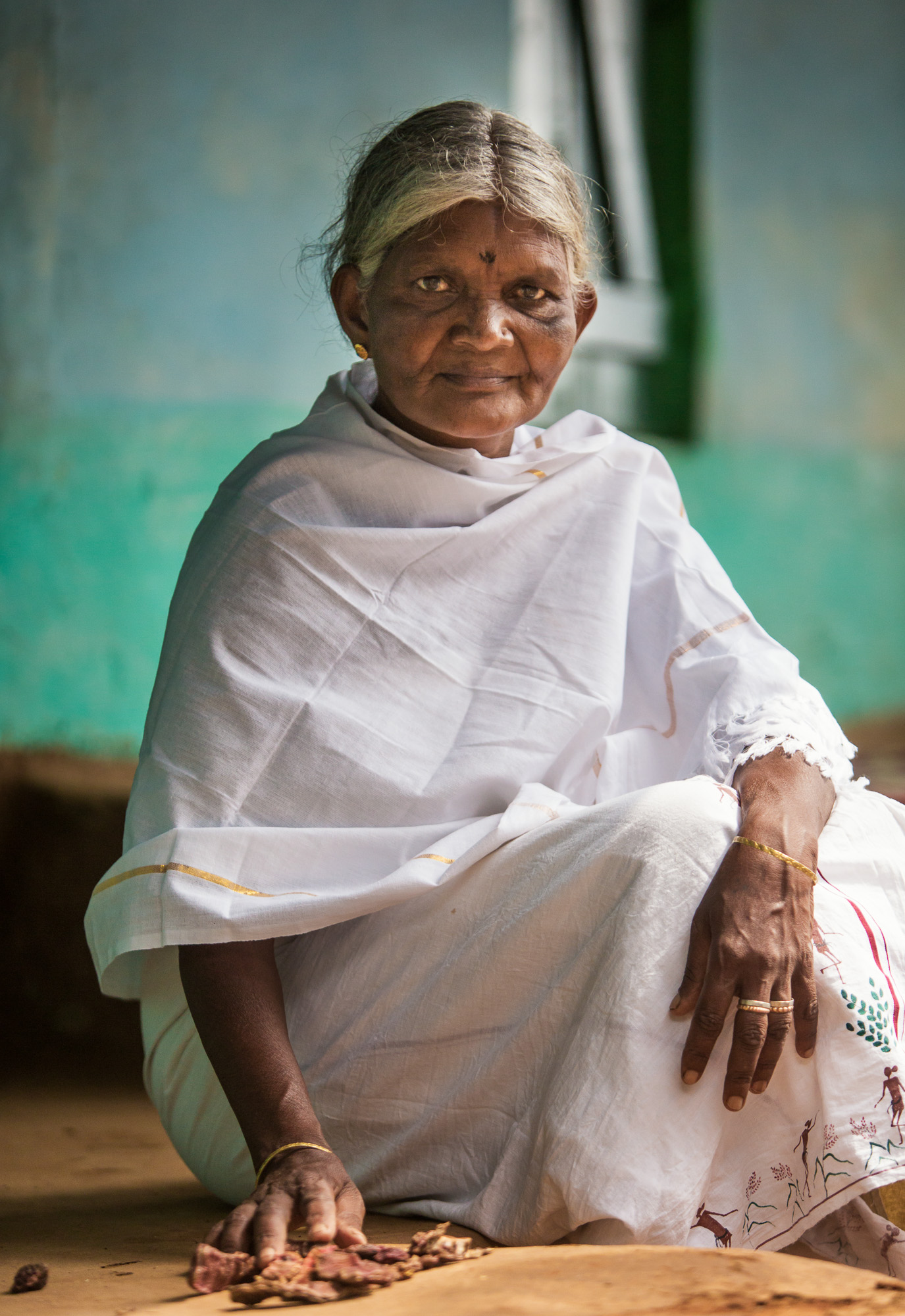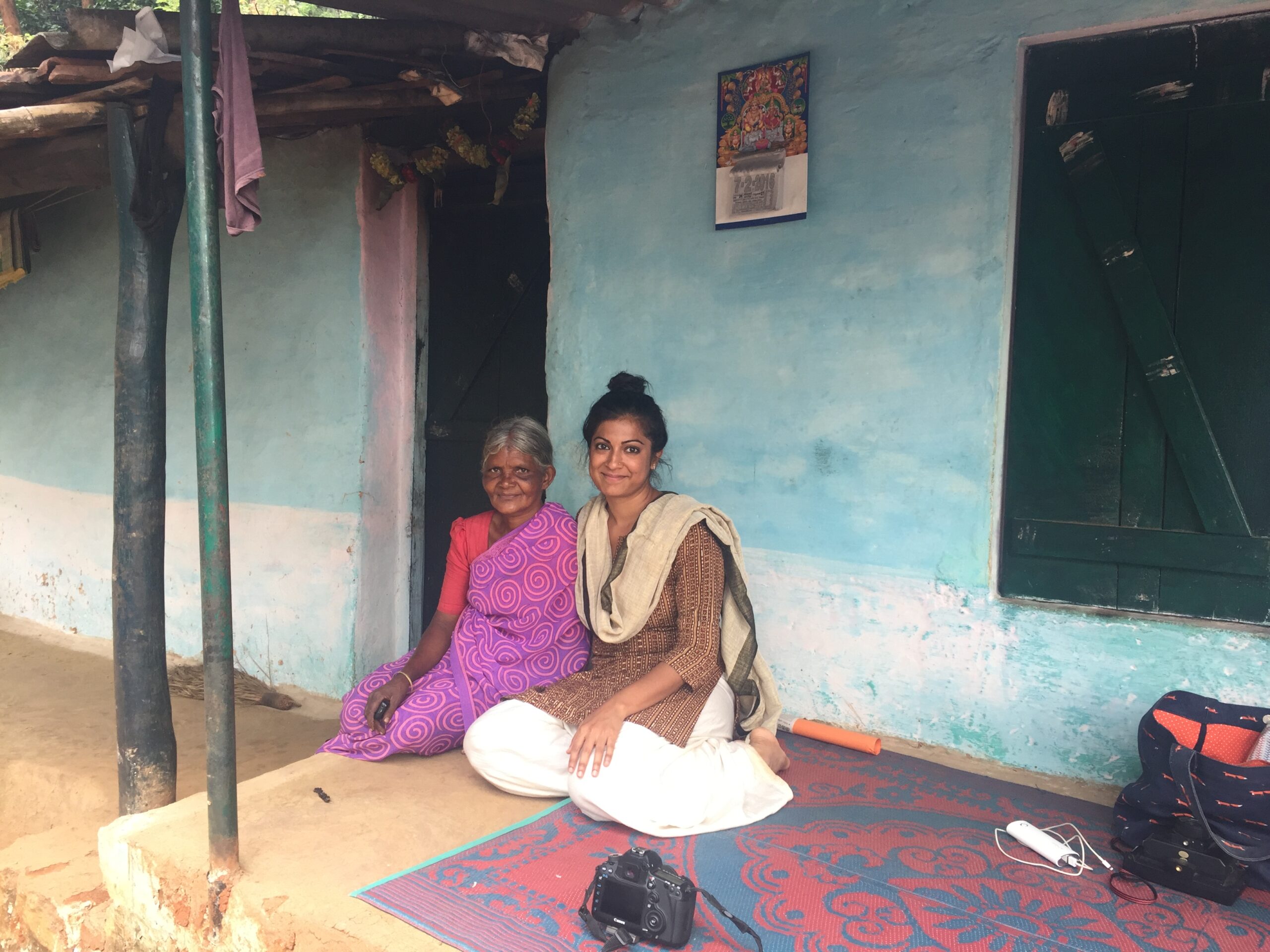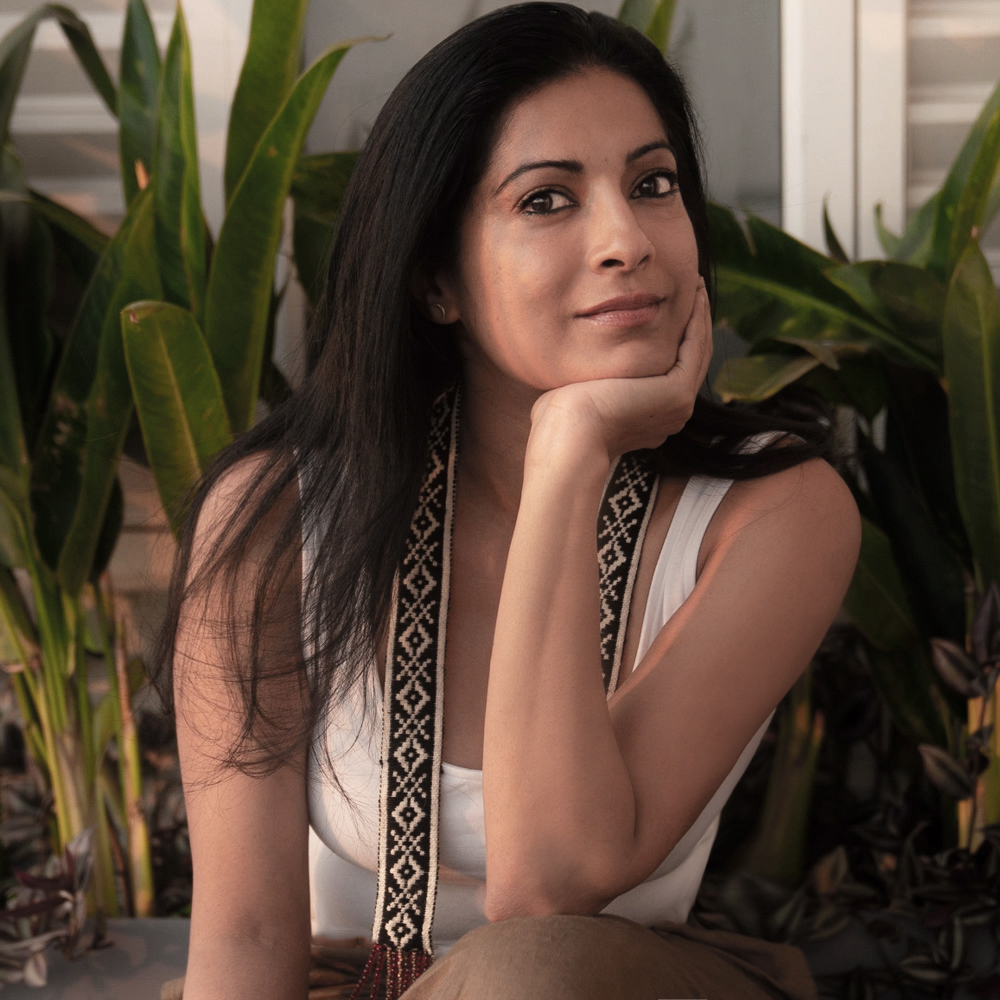The Keeper of Indigenous Memory: Remembering Janagiamma

In February 2016, I followed the winding trail from Mamaram to Vellaracombai to spend a day with Janagiamma, a revered Kurumba elder and healer. The morning was crisp, the sun already touching the tops of trees, and the air carried that dry, clean clarity peculiar to the winter in Nilgiris. Though she had given me precise instructions, I lost my way more than once: at a fork in the path, beside a shrine nestled beneath a gnarled trunk. Each time, someone appeared—quiet, matter-of-fact—to point me in the right direction. It felt less like navigating terrain and more like being gently returned to the land, watched over in ways I couldn’t quite name.
She welcomed me with an embrace and a carafe of spring water. I was hot and sweaty from the climb and instinctively poured the water over my head before I took a sip. She laughed and said, “It will get easier with time.” This was the path she walked every other day, down the slope and into the town and back, often balancing homegrown produce or a sack of peppercorns on her shoulder.
Her home was tucked into the hillside, surrounded by banyan trees wrapped in pepper vines, a courtyard filled with jackfruit, coffee, medicinal plants, and a kind of deep quiet that listens. I settled into that quiet, and she disappeared briefly into her kitchen. A few minutes later, she returned with two steel tumblers, filled with her slow-brewed, hand-ground coffee. There was always a trace of something in that coffee—warm, rooted, and almost sentient.
That day, she wore her azil pottu: a crescent symbol painted on her forehead with pigment made from local resin, its shape mirroring the traditional mortar and pestle. Among the Kurumbas, the azil signifies alignment with ancestral ways, a mark of presence and place. As we sat together, I told her I had paused on the trail to take in the small ancestral shrines. She nodded, as if I had merely acknowledged the obvious. “They are our people,” she said. “They remember.”

Her stories unfolded in layers woven with forest, memory, body, and rhythm. The plants in her yard, the pigments she wore, the tools she used, the chants she murmured before dusk—all belonged to a tradition of healing so integrated with place that it defied reduction.
The Kurumbas’ system of medicine was shaped by necessity and isolation. As hunter-gatherers who once roamed the forest freely, theirs was life in constant proximity to danger: snake bites, wild animal attacks, venomous insects, unpredictable terrain, and sudden illness. With no formal access to healthcare, their methods evolved from directly observing the land, understanding the specific properties of plants and minerals, and a reverent relationship with the unseen world. It was both an ecological and spiritual science. The healer was often the keeper of memory, tracking cycles of famine, epidemics, pregnancies, deaths, and generational ailments. A healer didn’t merely apply medicine. She listened, assessed, and often intervened on multiple planes.
When Janagiamma spoke of “kaathu,” it was not of wind or air, but an elemental disturbance within and around a person. The healer’s task was to diagnose that disturbance—to understand its emotional, spiritual, or relational origins. Often, she would prescribe medicines only after invoking chants, sometimes at dusk, sometimes facing a specific direction. She believed that the efficacy of these treatments depended not only on the ingredients but also on the healer’s intent and intuition. She called this “kai raasi”—the touch of grace or the destiny held in one’s hands. Not everyone could be a healer, even if they knew the recipes. The hands needed to carry the charge of the intent.
Knowledge in her world was not taught, but transmitted through osmosis, repetition, and doing. Janagiamma never confined herself to one role. She was a healer, a midwife, a barefoot journalist, and a community anchor. She was the Managing Director of Aadhimalai, an Indigenous producer enterprise allied with Keystone Foundation. She gathered wild pepper and medicinal plants, delivered babies, led projects across the Nilgiris, and moved between meetings, forest trails, and homes with the same clarity. These were not achievements she framed, but how she lived her ethics of care and responsibility.
Her recall was astonishing, and her grasp of people and places was exacting. Each month, she travelled across Kurumba and Irula villages collecting news: stories of births, deaths, land matters, and forest movements—memorizing every detail to report in Seemai Suddhi, the local Adivasi journal enabled by Keystone Foundation. Her youngest daughter, Sivamma, would transcribe her words at home. Even as a schoolgirl, Sivamma became part of this steady rhythm: listening, recording, and absorbing more than just information.
Years later, I came to know Sivamma more closely when she was in college, studying economics. Over time, I saw the tension she carried between two futures: one shaped by formal education and outward mobility, the other tied to something older and less easily named. Janagiamma hoped that Sivamma might return to learn the healing traditions after her studies. She had tentatively begun opening that world to her. But the crossroads were real. Choosing one often meant leaving the other behind. And I, too, had no answers, only the weight of knowing how much gets lost in that chasm between legacy and survival.

I sat with her one afternoon in Vellaracombai as she spoke about the rains. “If it doesn’t rain in April, we may have to move to another hamlet.” This wasn’t said in worry, but as a fact. Water was disappearing, and the seasons were no longer reliable. “Only once, about ten years ago, we had a drought,” she added. “We coped. But I fear this will be worse.”
Elders like Janagiamma lived with this kind of uncertainty every day. And yet, they carried within them a knowledge system so intimately tied to land and life that it held together communities, seasons, and survival—embodied in how seeds were saved, stories passed on, and rain understood by the shape of the clouds.
What does it mean to lose this kind of knowledge? What does it mean when the elders go quiet?
The silence they leave behind is not empty. It is full of things we forgot to ask, and can no longer retrieve.
One of the stories she shared was of Nalla Thangai, the Good Sister, who, after being turned away by her brothers, disappeared into the forest with her children. The next morning, a large stone was found in the middle of a lake, surrounded by six smaller ones. “They are still there,” she said with quiet certainty. I’ve seen stones like that across Kurumba hamlets—tucked beneath banyan roots, beside shrines, resting in silence. Many mark ancestors. Others hold memories passed down without words. These markers are how the land remembers.
Toda legends speak of the arrival of the first monsoons in the Nilgiris. Kaarsh and Kawntaiahh, two divine beings, were walking and shaping buffalo horns from fallen branches when they spotted a jamun tree. Kawntaiahh, after eating the fruit, spat out the seeds so forcefully that his breath turned into a monsoon wind. His saliva turned to mist and then to rain. To channel this new force, the gods created sacred checkpoints at the deity peaks—Nilgiri and Devabetta—where the mists would swirl and gather before being released across the land. These stories weren’t poetic devices. They were memory systems—climate knowledge, etched into place.
Kurumba honey gatherers have long approached bees only during particular seasons. The health of the forest determines their harvest quotas, and their songs often carry cues about when and how to gather. The Irulas had farming systems built on companion planting, natural pest control, and seasonal rhythms. They didn’t need labels for sustainability; their lives were sustainable.
Parts of this essay are drawn from my book, Soul of the Nilgiris, specifically from the chapters “Forest Healer” and “A Call to Connect.”
***

I last saw Janagiamma in December 2023 at Keystone Foundation during The Nilgiris Earth Festival. She had recently recovered from a life-threatening snake bite and was dressed in her traditional white sari, slightly weakened but unmistakably radiant. She had been hospitalized, and her recovery had taken time, but she stood with her usual composure, smiling easily. We caught up, laughed, and she said she had pepper waiting for me. For years, the only pepper I used at home came from Janagiamma’s forest garden. She set aside a couple of kilos for me each season before selling the rest. I still have two small boxes of the precious pepper—deep, sharp and rich with the scent of her hillside garden. Occasionally, she also sent us rare medicinal honey gathered at specific times in the year. “For Rajesh,” she’d say fondly. These came quietly, without explanation. Just her way of keeping us close.
She fell ill again with a fever some time in mid-2024. In early August, just a week before she passed, we spoke. She was upbeat, telling me about the the state of affairs on her side of the Nilgiris, and a meeting she had just returned from. As always, she was ready to begin again.
And then, she was gone.
On August 20th, sometime around four in the afternoon, Janagiamma was returning from a meeting with her companions when they were chased and attacked by a herd of elephants, just a few hundred metres from her home. It was completely unexpected and fatal. She had lived among these elephants all her life and knew their movements and silences. But something had shifted. The land she understood so well had been unsettled, its rhythms disrupted, its long-held balances worn thin.
That evening, around 7 p.m., a friend from Keystone Foundation called. There had been an incident, but nothing was certain. The Forest Department hadn’t reached the actual site; the elephants were still in the area. It would be hours before her death could be confirmed.
Some days later, her companions told us what she said in the final moments. As the elephants chased them, she turned back and said, “It has caught me, you go.” Not in panic, but with a calm urgency, it was a moment of clarity, instinct, and unspoken knowing: a surrender born not out of fear but out of care for those with her.
It brought back something she had once said to me, in 2020, when I visited her during the lockdown. She was farming a hillside plot near her home—millets, native chillies, and vegetables—and living part-time in a small shack to watch over the crops. We ate a simple, beautiful meal she had cooked on a firewood stove with produce from her land. Earlier that afternoon, we had spoken about the pandemic. And then, almost as if thinking aloud, she said: “I will never die in a hospital.”
And she didn’t. But there is a world of difference between peacefully returning to the land and being taken by a rupture in the very fabric she had spent her life tending. There is a difference between passing within nature and becoming a casualty of an imbalance born of systems that have pushed the forest, its animals, and its people too far.
Janagiamma’s death was a fissure that exposed the fault lines in our relationship with the land and the people who have safeguarded it for generations.
Indigenous communities like the Kurumbas are at the front lines of a polycrisis today—climate collapse, land degradation, and biodiversity loss. They are also the first to bear the consequences of a disruption they did not create. Man-animal conflict, such as the one that took Janagiamma’s life, does not occur in a vacuum. It arises from the fragmentation of forests, the rerouting of migration paths, the pressures of tourism, urban expansion, monoculture plantations, and extractive development. And it is communities like hers that are caught in the crosshairs of these decisions, made elsewhere, in languages they do not speak and rooms they are not invited into. They are made vulnerable not only by location but also by systemic exclusion. They continue to live in places where policy, protection, and basic access remain disorganized and chaotic. They are simultaneously relied upon for their “indigenous knowledge” and marginalized in the very forums where that knowledge could inform meaningful change.
We say their culture is fading. But who is erasing it?
We say there is so much to learn from them. But are we listening to the land and its keepers?
We say they live in harmony with nature. But have we even begun to comprehend what that harmony costs?
We often ask why the younger generation is not “continuing” traditional practices. But do they even have a choice? Have we created systems that make such options viable, respected, and economically sustainable? Or are these questions merely rhetorical, convenient opportunities to absolve ourselves?
From the time I first knew Janagiamma, I asked not to be called “madam.” I said it gently, often, asking her to use my name instead. But she wouldn’t relent. “I’m used to it,” she’d say, smiling. It wasn’t distance but an old thread that held, no matter how close we became. And it was disconcerting, even saddening, that a revered elder like her should feel the need to address me so. It said something about the stubbornness of the gap between us—not personal, but systemic. A reminder that the hardest hierarchies to dismantle are the ones that pass as respect.
The burden to “preserve” a way of life, a community, or a plant cannot fall on those who are also asked to survive. If there is to be a legacy, an earth for future generations, there must equally be empathy, social justice, and a deep understanding of our environment. Pedagogies must change. It is not enough to add “tribal stories” to textbooks. A tribal child should grow up knowing that their knowledge has value. An urban child should grow up learning the names of local trees, migration cycles, and when the bees arrive. The curriculum must become a space of convergence, not erasure.
Tyson Yunkaporta, an Aboriginal academic and author of Sand Talk: How Indigenous Thinking Can Save the World, writes of the “right story” and “wrong story.” The right story emerges from people in “right relation” with land and each other. The wrong story is extractive, detached, and flattened. It leaves behind irrevocable damage.
Much of what we call development is a wrong story, and much of how we respond to loss is a wrong story.
Media coverage of Janagiamma’s death was cursory, described in a few passing lines: “Tribal woman trampled by an elephant.” A note. A statistic. A trope. The carelessness in language is its own kind of violence. This is the arrogant face of the majority media—an entity that decides who matters, and what is worthy of collective grief.
G.N. Devy, a noted Indian linguist and scholar of Adivasi cultures, reminds us that every lost language is a lost worldview. Languages live not only in syntax or structure—they live in medicinal gardens, in chants muttered under one’s breath, in the precise moment peppercorns are picked.
In the past year alone, I have seen other elders pass. One Toda elder I had only recently interviewed and photographed. Another, just as I had begun archiving Toda embroidery traditions, before I could return to listen and learn more. Both departed with their songs, stories, and irreplaceable understanding of the lands they inhabited.
We still have elders among us, and we still have time to invoke their wisdom. But we must begin to acknowledge their presence with the reverence it demands. We must see them not as cultural relics or endangered sources of knowledge but as sovereign, contemporary beings whose worldviews—if truly respected—require us to dismantle our own.
I still speak to some of them. I feel the tremor of that connection more acutely now—with love, yes, but also with a kind of sacred fear that understands what we are losing and what we have already lost.
To call Janagiamma’s death an accident is to misread it.
It was not a singular tragedy, but the culmination of years of silent erosion.
This loss runs deeper than the personal. It is part of a larger unravelling. And so, too, must be our reckoning.
Memory alone will not carry us forward.
We must reimagine how we relate to the land, to those who came before us, and to the futures they were not allowed to carry.

With Janagiamma at her home in Vellaracombai, February 2016.

